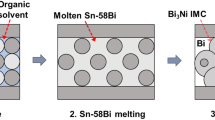Abstract
For high-temperature-resistant packaging of new generation power chip, a chip packaging simulation structure of Ni/Ni-Sn/Ni was bonded by a transient liquid-phase sintering process. High-temperature aging experiments were carried out to investigate joint heat stability. The microstructural evolution and mechanism during aging, and mechanical properties after aging were analyzed. The results show that the 30Ni-70Sn bonding layer as-bonded at 340°C for 240 min is mainly composed of Ni3Sn4 and residual Ni particles. When aged at 350°C, because of the difficulty of nucleation for Ni3Sn and quite slow growth of Ni3Sn2, the bonding layer is stable and the strength of that doesn’t change obviously with aging time. When aging temperature increased to 500°C, however, the residual Ni particles were gradually dissolved and the bonding layer formed a stable structure with dominated Ni3Sn2 after 36 h. Meanwhile, due to the volume shrinkage (4.43%) from Ni3Sn2 formation, a number of voids were formed. The shear strength shows an increase, resulting from Ni3Sn2 formation, but then it decreases slightly caused by voids. After aging at 500°C for 100 h, shear strength is still maintained at 29.6 MPa. In addition, the mechanism of void formation was analyzed and microstructural evolution model was also established.
Similar content being viewed by others
References
P.G. Neudeck, D.J. Spry, L.Y. Chen, G.M. Beheim, R.S. Okojie, C.W. Chang, R.D. Meredith, T.L. Ferrier, L.J. Evans, M.J. Krasowski, and N.F. Prokop, IEEE Electron Device Lett. 29, 456 (2008).
T. Iwasaki, Y. Hoshino, K. Tsuzuki, H. Kato, T. Makino, M. Ogura, D. Takeuchi, H. Okushi, S. Yamasaki, and M. Hatano, IEEE Electron Device Lett. 34, 1175 (2013).
R. Hedayati, L. Lanni, S. Rodriguez, B.G. Malm, A. Rusu, and C.M. Zetterling, IEEE Electron Device Lett. 35, 693 (2014).
M. Le-Huu, H. Schmitt, S. Noll, M. Grieb, F.F. Schrey, A.J. Bauer, L. Frey, and H. Ryssel, Microelectron. Reliab. 51, 1346 (2011).
D.R. Myers, K.B. Cheng, B. Jamshidi, R.G. Azevedo, D.G. Senesky, L. Chen, M. Mehregany, M.B.J. Wijesundara, and A.P. Pisano, J. Micro Nanolith Mem. 8, 021116-1 (2009).
H.S. Chin, K.Y. Cheong, and A.B. Ismail, Metall. Mater. Trans. B 41, 824 (2010).
D. Maier, M. Alomari, N. Grandjean, J.F. Carlin, M.A. Diforte-Poisson, C. Dua, S. Delage, and E. Kohn, IEEE Electron Device Lett. 33, 985 (2012).
I. Ohnuma, R. Kainuma, and K. Ishida, J. Min. Metall. B 48, 413 (2012).
P.O. Quintero and F.P. Mccluskey, J. Microelectron. Electron. Packag. 6, 66 (2009).
M. Fujino, H. Narusawa, Y. Kuramochi, E. Higurashi, T. Suga, T. Shiratori, and M. Mizukoshi, Jpn. J. Appl. Phys. 55, 04EC14-1 (2016).
H. Greve and F.P. Mccluskey, in Proceedings of ASME 2013, Burlingame (2013).
F.Q. Lang, H. Yamaguchi, H. Nakagawa, and H. Sato, in Proceedings of ICEPT-HDP 2012 (IEEE, Guilin, 2012).
F.Q. Lang, H. Yamaguchi, H. Nakagawa, and H. Sato, J. Electrochem. Soc. 160, D315 (2013).
S.F. Corbin and D.J. McIsaac, Mater. Sci. Eng. A Struct. 346, 132 (2003).
H. Okamoto, J. Phase Equilib. Diffus. 29, 297 (2008).
H.L. Feng, J.H. Huang, J. Zhang, X.D. Zhai, X.K. Zhao, and S.H. Chen, in Proceedings of EPTC2015 (IEEE, Singapore, 2015).
H.L. Feng, J.H. Huang, J. Yang, S.K. Zhou, R. Zhang, and S.H. Chen, J. Electron. Mater. 46, 4152 (2017).
H.J. Ji, M. Li, S. Ma, and M.Y. Li, Mater Design 108, 590 (2016).
S. Bader, W. Gust, and H. Hieber, Acta Mater. 43, 329 (1995).
A. Lis, S. Kicin, F. Brem, and C. Leinenbach, J. Electron. Mater. 46, 1 (2017).
K. Chu, Y. Sohn, and C. Moon, Scr. Mater. 109, 113 (2015).
X.M. Li, S.F. Zhang, X.F. Wang, and J.X. Qi, J. Cent. South Univ. Technol. 15, 341 (2008).
T. Chen, Z.X. Jiang, H. Peng, H.L. He, L.L. Wang, and Y.G. Wang, Strain 51, 190 (2015).
Author information
Authors and Affiliations
Corresponding author
Rights and permissions
About this article
Cite this article
Feng, H., Huang, J., Peng, X. et al. Microstructural Evolution of Ni-Sn Transient Liquid Phase Sintering Bond during High-Temperature Aging. J. Electron. Mater. 47, 4642–4652 (2018). https://doi.org/10.1007/s11664-018-6336-0
Received:
Accepted:
Published:
Issue Date:
DOI: https://doi.org/10.1007/s11664-018-6336-0




